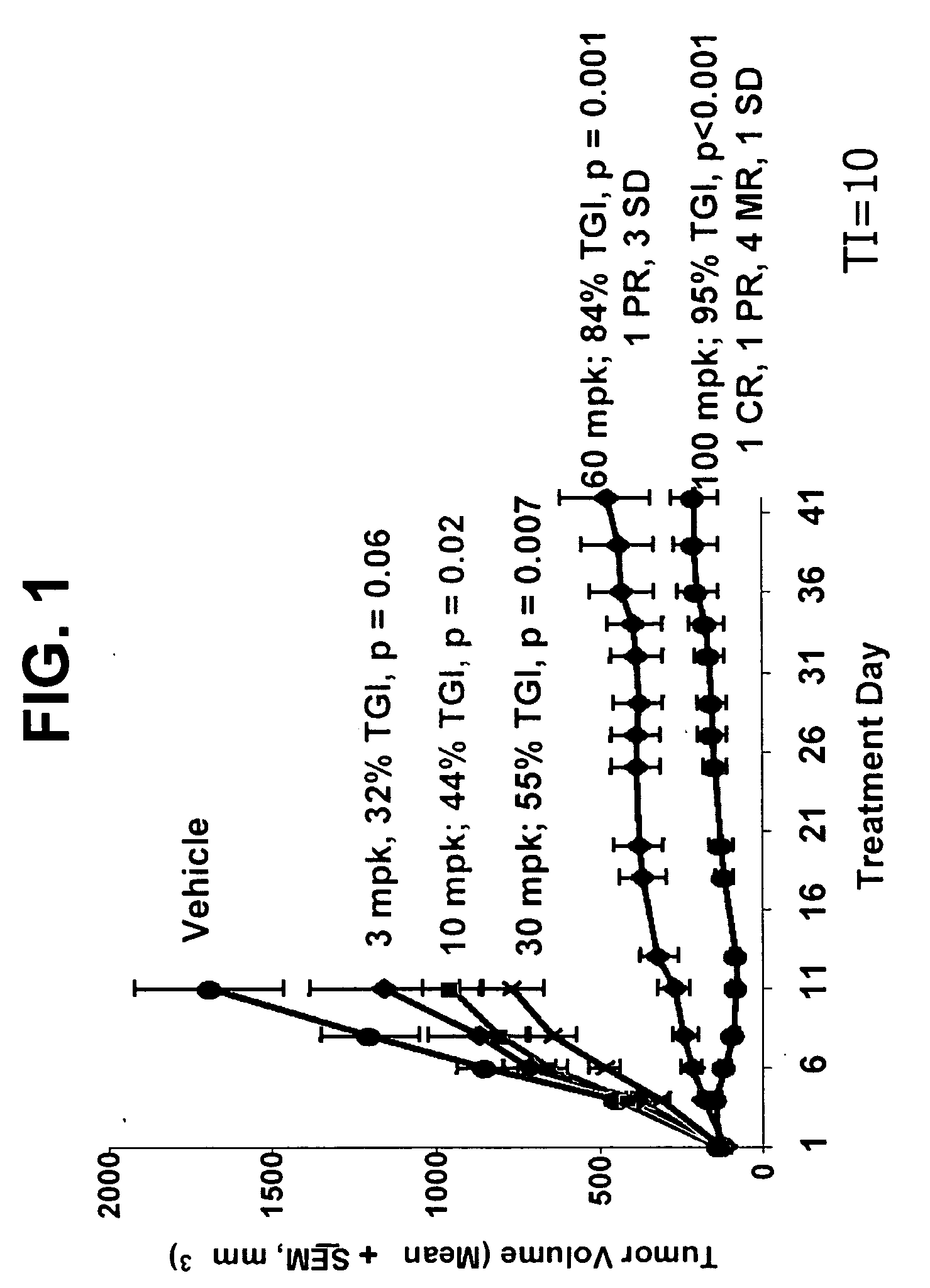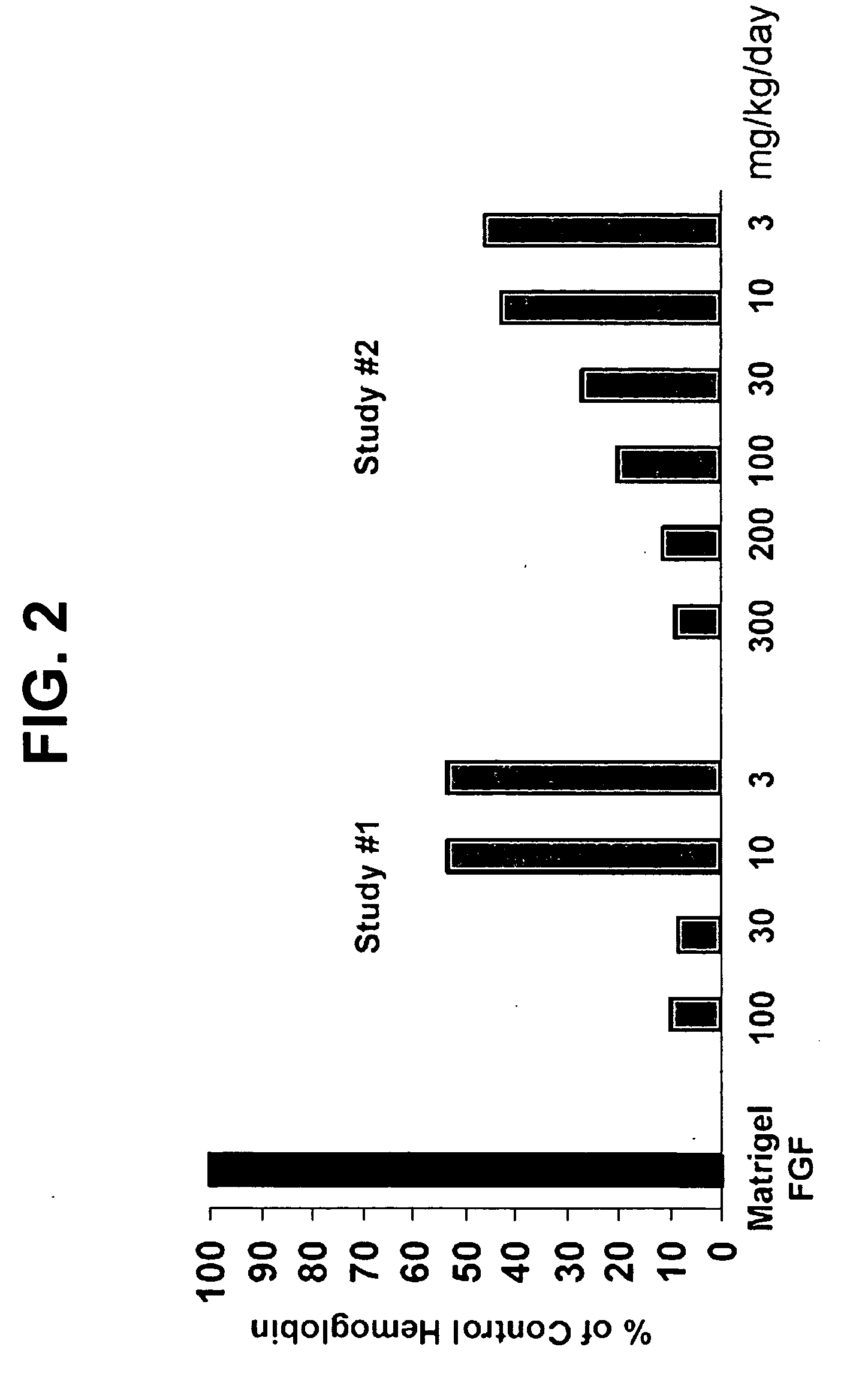Inhibition of FGFR3 and treatment of multiple myeloma
a technology applied in the field of inhibition of fgfr3 and treatment of multiple myeloma, can solve the problems of poor prognosis of aml patients, interference with tumor growth and angiogenesis, and small molecule pdgfr kinase activity of small molecules
- Summary
- Abstract
- Description
- Claims
- Application Information
AI Technical Summary
Problems solved by technology
Method used
Image
Examples
example 1
Synthesis of 4-Amino-3-benzimidazol-2-yl-6-(4-methylpiperazinyl)hydroquinolin-2-one
Step 1: Ethyl 2-benzimidazol-2-ylacetate
[0719] A solution of 1,2-phenylenediamine (1.0 equivalent) and ethyl 3-ethoxy-3-iminopropanoate hydrochloride (1.3 equivalents) in ethanol was stirred at 90° C. overnight. The reaction was cooled to room temperature and the solvent was removed in vacuo. Water and CH2Cl2 were added to the residue. The organic layer was separated, dried over Na2SO4 and the solvent removed. The solid recovered was used without purification. LC / MS m / z 205.2 (MH+), Rt 1.44 minutes.
Step 2: 5-(4-Methylpiperazinyl)-2-nitrobenzenecarbonitrile
[0720] 5-Fluoro-2-nitrobenzenecarbonitrile (1.02 equivalents) and N-methylpiperazine (1.0 equivalents) were dissolved in NMP. Triethylamine (2.1 equivalents) was added, and the resulting solution heated at 100° C. for 1 hour. The solution was cooled to room temperature and poured into H2O. A precipitate formed which was filtered to yield the desi...
example 2
Synthesis of 4-Amino-3-benzimidazol-2-yl-5-(2-morpholin-4-ylethoxy)hydroquinolin-2-one
Step 1: 6-Amino-2-(2-morpholin-4-ylethoxy)benzenecarbonitrile
[0723] 4-(Hydroxyethyl)morpholine (1.02 equivalents) was added to NaH (1.2 equivalents) in NMP. After 10 minutes, 6-amino-2-fluorobenzenecarbonitrile (1.0 equivalent) was added in NMP. The resulting mixture was heated at 100° C. for 1 hour. The mixture was then cooled and poured into H2O. The aqueous layer was extracted with EtOAc. The combined organic layers were washed with brine, dried over Na2SO4, filtered, and concentrated in vacuo to a yield a brown gum. The crude material was purified by silica gel chromatography (5:1:95 MeOH:Et3N:EtOAc) to give the desired product. LC / MS m / z 248.3 (MH+), Rt 1.26 minutes.
Step 2: 4-Amino-3-benzimidazol-2-yl-5-(2-morpholin-4-ylethoxy)hydroquinolin-2-one
[0724] The title compound was synthesized as described in Example 1 (Step 4), using 6-amino-2-(2-morpholin-4-ylethoxy)benzenecarbonitrile. LC / MS m...
example 3
Synthesis of 4-Amino-3-[5-(2-morpholin-4-ylethoxy)benzimidazol-2-yl]-6-nitrohydroquinolin-2-one
Step 1: 4-(2-Morpholin-4-ylethoxy)-2-nitrophenylamine
[0725] Diisopropyl azodicarboxylate (1.1 equivalents) was added dropwise to a stirred solution of 4-amino-3-nitrophenol (1.0 equivalent), triphenylphosphine (1.1 equivalents), and N-(2-hydroxyethyl)morpholine (1.0 equivalent), in THF at 0° C. The mixture was allowed to warm to room temperature and left to stir for 18 hours. The solvent was evaporated and the product was purified by silica gel chromatography (98:2 CH2Cl2:MeOH) to yield a dark reddish-brown oil. LC / MS m / z 268.0 (MH+), Rt 1.01 minutes.
Step 2: 4-(2-Morpholin-4-ylethoxy)benzene-1,2-diamine
[0726] To a solution 4-(2-morpholin-4-ylethoxy)-2-nitrophenylamine (1.0 equivalent) in EtOH was added Pd / C (0.1 equivalents). The reaction vessel was repeatedly purged with hydrogen, then stirred under a hydrogen atmosphere (1 atm) for 18 hours. The product was filtered through a Celite ...
PUM
| Property | Measurement | Unit |
|---|---|---|
| Structure | aaaaa | aaaaa |
Abstract
Description
Claims
Application Information
 Login to View More
Login to View More - R&D
- Intellectual Property
- Life Sciences
- Materials
- Tech Scout
- Unparalleled Data Quality
- Higher Quality Content
- 60% Fewer Hallucinations
Browse by: Latest US Patents, China's latest patents, Technical Efficacy Thesaurus, Application Domain, Technology Topic, Popular Technical Reports.
© 2025 PatSnap. All rights reserved.Legal|Privacy policy|Modern Slavery Act Transparency Statement|Sitemap|About US| Contact US: help@patsnap.com



